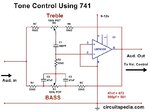Thayne
Member level 3

A couple weeks ago, I made a simple amp circuit with a TDA1517 chip. Now, I want to add a bass/treble and volume control circuit before the amp. There are a lot of example circuits online, I have seen too many to list. That is the first issue, picking one. My second issue is everyone is always complaining about every circuit -- there are so many experts it seems; so, it is difficult, as a beginner, to know who is making mountains out of molehills, full of BS, ego, etc.
What I have are a these LM741 op amps. A pile of them and all the resistors and capacitors to build with. I read that this LM741 is an old school, go to chip for this sort of thing I want to do (sounds perfect). A lot of people were saying bad things about obsolescence and better options, etc. I don't care. I have them and it is a good chip to learn with (so I read somewhere). I know the issue of the two power supplies or using one and making the artificial reference ground. OK, no problem.
So, I found a circuit I think is OK. First, I know there are a million opinions, but is there anything obvious to a experienced person why to pick something else? Or, maybe there is an old school, go to circuit to go with the old school, go to chip that I didn't find yet?
Thank you!
What I have are a these LM741 op amps. A pile of them and all the resistors and capacitors to build with. I read that this LM741 is an old school, go to chip for this sort of thing I want to do (sounds perfect). A lot of people were saying bad things about obsolescence and better options, etc. I don't care. I have them and it is a good chip to learn with (so I read somewhere). I know the issue of the two power supplies or using one and making the artificial reference ground. OK, no problem.
So, I found a circuit I think is OK. First, I know there are a million opinions, but is there anything obvious to a experienced person why to pick something else? Or, maybe there is an old school, go to circuit to go with the old school, go to chip that I didn't find yet?
Thank you!







